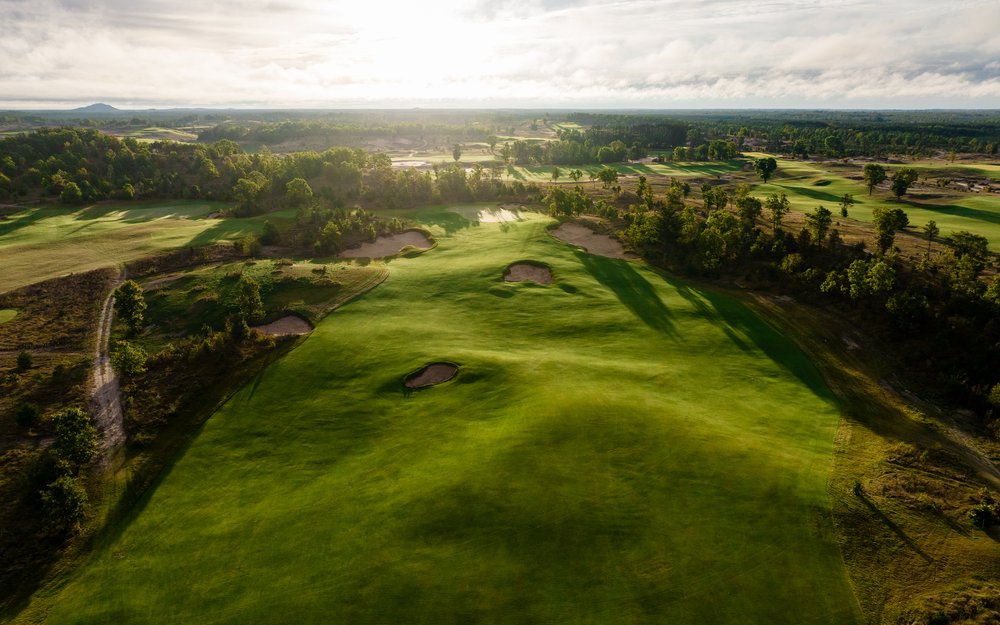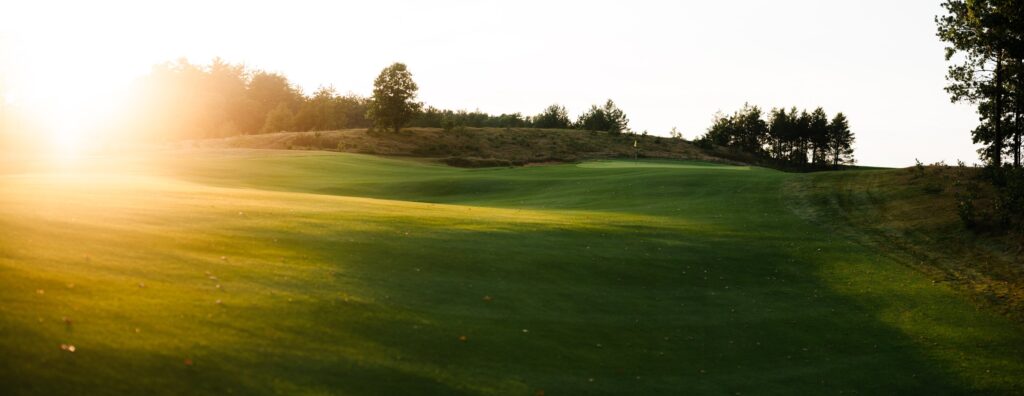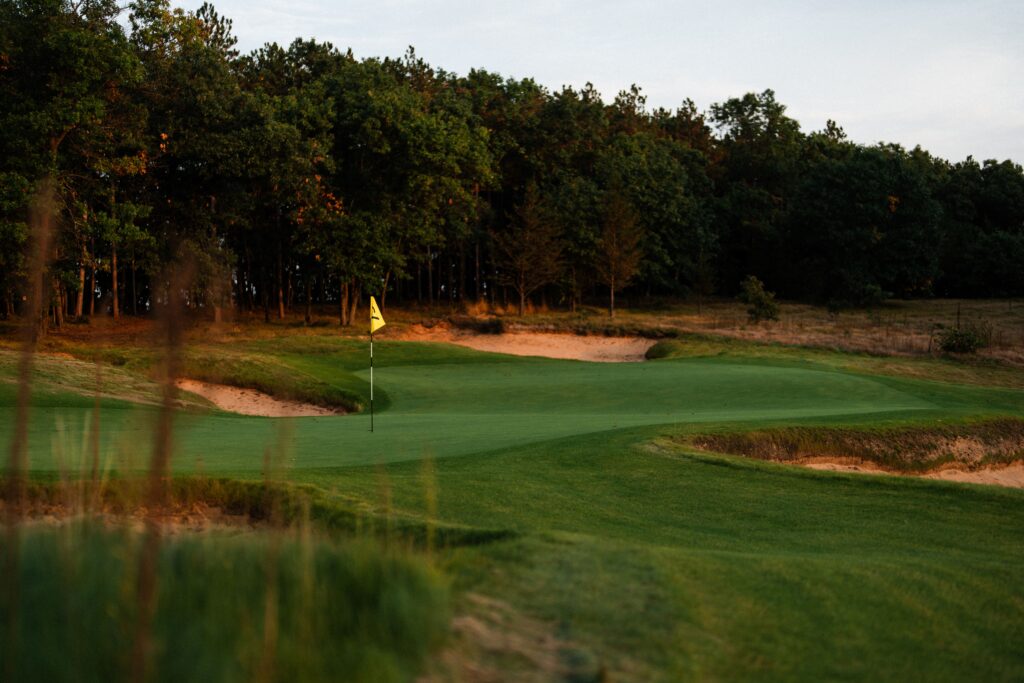
Sedge Valley
Just more than a decade ago, Michael and Chris Keiser, the sons of Bandon Dunes Founder Mike Keiser, purchased 1,700 acres of rolling land filled with majestic Red Pines in a remote section of central Wisconsin. The intention was to develop a world-class inland links golf destination.
By 2020, they had three courses in play, lodging and a clubhouse.
As it turns out, the courses, Sand Valley, Mammoth Dunes, and the Sandbox short course were just the first wave. Today, Sand Valley has evolved into a 12,000-acre mecca of minimalist architecture and one of the finest golf destinations in North America.
In 2023 and 2024, Sand Valley opened two new courses, both built by Tom Doak — The Lido and Sedge Valley. The original Lido was a C.B MacDonald golden age course in Long Island that fell victim to economics and the war in the 1940s. Peter Flory’s incredible 3D design renderings recreated the design for Tom Doak and the Renaissance team to build. The Lido opened in 2023, as a member club that offers limited access to resort guests. We think that Sedge Valley, the fifth course at the resort will likely be the most popular and here’s why.

Sedge Valley
Nothing short of a masterpiece
Sedge is a masterclass from Tom Doak on how to create intrigue, challenge, and fun, by removing distance as the main component and emphasizing the importance of accuracy and greenside creativity. On several holes the surrounds give you options via playing along a contour that will feed the ball towards a hole location, and conversely, several where the intelligent strategy is to simply play away from a certain hole location. In some cases, firing at the flag may be too enticing to pass up, but just know, it’s likely to be “fools gold”.
The downhill par-3 fifth at Sedge Valley features a wide but shallow diagonal green with bold contours Sedge Valley has a completely different vibe and flavor than its brethren. This is not a layout that favors those that swing out their shoes with little regard for position and strategy. It’s only 5,829 yards and plays as a par-68 with just one par-5. The forward markers play a mere 3,753 yards.
At these yardages, you’d expect Sedge Valley to be a niche part of the Sand Valley portfolio, a pushover that better players would have little use for. In reality, it’s quite the contrary as the layout provides choices with the clubs in your bag you hopefully feel the most confident with – your wedges. Early feedback shows Sedge Valley is quickly becoming the resort’s most popular course.
Tom Doak describes what makes Sedge Valley so unique: “When you don’t have to think about stretching a course to 7,300 yards, you can start thinking about finding cool green sites, without worrying about how close together they are. The sixth at Sedge Valley is a 290-yard par-4 with a skinny shelf of a green. It’s the kind of hole that actually gets long-hitters into trouble because they feel compelled to attack even when it’s not wise. That freedom from length also means that back-to-back par-3 holes are fine, provided they’re different. The seventh and eighth at Sedge Valley are 119 yards and 143 yards, respectively. So, the overall design does allow us to focus more on the green sites themselves. I don’t have to worry as much about a severe slope at the edge of the green being “unfair” if you’re hitting a relatively short approach into it. You look for great green sites. We found them here, and it’s a credit to Michael and Chris that they have allowed us to build around those great sites.”
The terrific trio of holes on the outward side concludes at this superb shorty – the 144-yard seventh hole. Doak expands on his inspiration for the design at Sedge Valley: “Harry Colt did hundreds of great courses on all types of property, including heathland and links courses, and he was one of several designers whose best work remains relevant, interesting and challenging. The inspiration for Sedge Valley comes from a handful of courses that never expanded much beyond their original scope – Colt’s Swinley Forest and Rye, Sir Guy Campbell and C.K. Hutchison’s West Sussex, Woking by Tom Dunn, The Addington by J.F. Abercromby, and Tom Simpson’s New Zealand Golf Club. These are designs that have remained essentially unchanged over time. I can’t think of a higher standard.”

Sedge Valley
Recommendation
Perhaps the biggest compliment you can pay to a golf course other than, “I remember every hole, and when can we play it again.” Another factor that we put a lot of importance in is the enjoyment of “the walk” around the course. The natural heathland like landscape and environment will have you feeling like you’ve been dropped into Surrey, England. And for someone who lives in an area with a ton of golf redundancy, it accentuates the uniqueness of this property and none of that has anything to do with the birdies and bogeys side of the experience. On the architectural side of the ledger, there’s a vital element at Sedge Valley that also resonates in glowing terms.
There are constant choices to be made throughout the round, and picking the correct one that suits your skill set will likely be rewarded with a chance to make something good happen. The design provides that in spades, and it’s hard to imagine a better golf concept than that. While your first reaction may be cynical because of the yardage, Sedge Valley is a must-play experience. Sharpen your wedge game before you arrive and have a day.
When booking your golf vacation here, the accommodations include five different varieties of lodging that are available for guests. And while you can book tee times here only, staying onsite is worth trying to do but you’ll need to plan accordingly as these often sell out fast.

